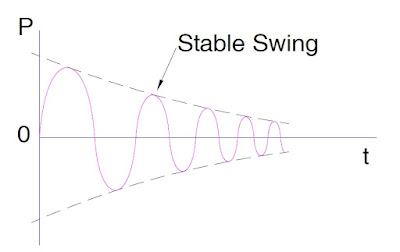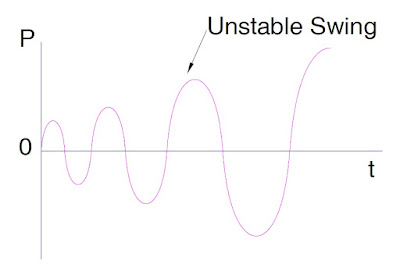Steady State & Transient State Stability
Power System instability is basically of two forms: a) Instability of Load which means stalling of Synchronous Load connected to the system. b) Pole slipping or out of step of Generators connected to the Synchronous Grid known as Synchronous Instability. Synchronous Stability is categorized into two:
1) Steady State Stability
2) Transient State Stability
Steady State Stability
Steady State Stability is defined as the stability of system under slow or gradual change in load. It is assumed that the rate of change of load is comparatively low when compared with the rate of change of field flux of machine/generator in response to change in load.
Note: There are two types of Grid, Synchronous Grid and Asynchronous Grid. In Synchronous Grid all the Generators connected operate at same speed viz. 3000 rpm. This is necessary to maintain a constant frequency of 50 Hz of Grid. On the other hand, in asynchronous grid, different generators operate at different speed. This means that frequency of two Asynchronous Grids will be different. Two asynchronous grid are connected to each other via HVDC link. |
Basically any change in system condition leads to swing. Swing is nothing but the relative motion between the connected machines. Whenever there is any change, all the connected machines try to cope up the change. This give rise to relative motion i.e. Swing. Swing can be either in power or other electrical quantity. Now for system to be stable, these swings should be damped out as quickly as possible. The damping in Generator is mainly provided by Inertia of Rotor H, Damper winding, Field Winding etc. Figure below shows a stable swing. As can be seen from the figure, the swing/disturbance dies out.
But there are some conditions / operating points of Generator in which such swings/disturbance do not die out. Such kind of swing/disturbance is known as unstable swing. If no proper measure is taken then the Generator will definitely loose synchronism and become unstable.
Transient State Stability
Transient State Stability is capability of system to be stable when there is a sudden or large change in system condition like load, fault at a point, change is mechanical input to the rotor shaft of Generator etc.
Dynamic Stability
Apart from the steady state and transient state stability, there is one more kind of stability called Dynamic Stability. Modern Generators are equipped with fast acting Voltage Regulators. These regulators are capable of changing the field flux very quickly. Therefore the rate of change of flux is quite more when compared to rate of change of load. This is why the stability limits are increased by the fast acting voltage regulators.
Dynamic Stability is same as steady state stability but the main difference lies in enhanced rate of change of flux capability due to regulators. This is the origin of Power System Stabilizer (PSS) which forces the voltage regulator to respond to transients quicky to change field flux. I will be elaborating System Stabilizer (PSS) in next post.
Steady State & Transient State Stability
 Reviewed by haru
on
September 21, 2017
Rating:
Reviewed by haru
on
September 21, 2017
Rating:
 Reviewed by haru
on
September 21, 2017
Rating:
Reviewed by haru
on
September 21, 2017
Rating:










No comments